(Psst: The FTC wants me to remind you that this website contains affiliate links. That means if you make a purchase from a link you click on, I might receive a small commission. This does not increase the price you’ll pay for that item nor does it decrease the awesomeness of the item. ~ Daisy)
Baby chicks…they’re adorable, fluffy, and incredibly delicate! Despite their fragility, they’re actually pretty simple to raise. If you have some outdoor space and live in an area where it’s allowed, fresh eggs and meat (if you’re interested in that) can easily be yours!
I don’t have 20 years of experience with baby chickens. However, I’ve raised 4 batches of them. Each new batch was more successful than the one before. Just like any other new skill, it works best if you simply find a reliable guide, plunge in, and learn “on the job.” Below, we’ll talk about how to get started on the most adorable hobby around. Trust me – anyone can do this! This article contains basically everything you need to know to get started raising baby chicks.
Before You Start.

Furthermore, some states require an “egg handler’s license” before you can sell, give away, or otherwise distribute fresh eggs. We’ve come a long way from the days when being self-reliant was seen as your patriotic duty.
Because of this, if you live in an urban or suburban area, be sure to check the bylaws before bringing your birds home. Often, you can find information on this forum about your town’s specific chicken bylaws.
Discretion is the Better Part of Valor, to Borrow a Phrase From Shakespeare.
It would be irresponsible to recommend breaking the law, of course. (coughs) I’ve heard, although chickens aren’t exactly stealth animals, sometimes if you pay protection in eggs, neighbors will look the other way. Of course, that is, as long as there are no roosters crowing at 4 am or hens enjoying their rosebushes.
I loved having a source of organic meat and eggs in my own backyard. Don’t be intimidated! I started as a total newbie and within about a year, thanks to the internet, my personal library, and some knowledgeable friends, I successfully produced protein. If I could do this, you can too!
Where Can I Get My Baby Chicks?
Baby chicks are everywhere from February through June. You can get yours mailed to you from a reputable hatchery (that’s where my current flock of 25 Freedom Ranger babies came from) or you can pick yours out at your local feed store. (That’s where I got most of my babies.) Sometimes you can even buy older chicks that are closer to laying age and out of the fragile stage. (I got 3 Barred Rock girls that way.) You can also find them on Craigslist in the Farm and Garden section.
Here are some articles that go into more detail about acquiring your fluffy new babies.
However you get them, it’s very likely that the baby chicks are only going to be a couple of days old when you get them home. Like any newborn, they’re exceptionally fragile. You may lose a few. It’s very sad when this happens, but most of the time, it isn’t your fault. Sometimes there is a physical issue with the chick that doesn’t allow it to survive, sometimes they get sick, and sometimes an accident occurs. (They’re prone to drowning in their water, for example, but we’ll talk about precautions.)
Before you bring your babies home, you need to have a few things on hand. Here is my own list of must-haves.
A Brooder to House the Baby Chicks
Mine was very similar to this one. However, I had someone local build it for me. We kept it in the laundry room for the first week if it was cold outside, then on the porch, then we moved it out to the coop. The good thing about using something like this as a brooder is that it can pull double duty as your infirmary if you need to separate a sick or injured chicken from the flock.
If you plan to raise chickens for meat a couple of times per year, a permanent brooder is a good investment. The image to the left is the brooder we had out on our back deck.
But, if you are just raising a few backyard laying hens and don’t plan to raise new chickens every year, there is no need to go crazy expensive. Below, you can find some really awesome DIYs.
Here’s a Brooder You Can Make for Less Than $12!
Before I got my big brooder, I made one similar to this, except I didn’t fasten the hardware cloth to the top. I cut the hardware cloth bigger than the opening of the Rubbermaid container where it would hang down over the edges, and simply snapped the lid with the hole cut out on top of it. I’m all about the shortcuts and not always the handiest soul around.
Here Are More Brooder Set-Up Articles.
This link has some videos about incubating eggs and brooding the chicks once they hatch.
How We Brood Chicks (there’s another really cool DIY brooder in this article.)
Baby Chicks Need a Heat Source!
Baby chicks must stay warm, or they’ll die. If they were being raised by their mama, they would huddle underneath her to stay cozy. Since you are the mama, and if you sat on them it wouldn’t end well for anybody involved, you have to go with other methods. The least expensive way to keep them warm is by using a standard heat lamp and a red bulb. A red bulb is recommended instead of a white one so that the chicks sleep better. This is the method that I used for all my chicks.
But please use extreme caution when heating this way. Many a tragedy has started with a heat lamp. I had a near fire from one out in a wooden chicken coop my first year raising chicks. Luckily, I caught it just as it began smoking, but it could have been a disaster. It can’t be touching anything flammable or meltable, nor can it be too close to the babies. Be sure to hang it in a way that the chicks can get away from the heat if they get too warm.
Another excellent heat source is the EcoGlow. This piece of awesomeness has far less risk of fire or harm to the chicks. However, it costs a lot more than the standard heat lamp. A friend of mine owned one and it’s a really great method of brooding chicks. You can raise it up as they grow, allowing more room underneath.
How Do You Tell if the Temperature is Right?
Invest in a cheap digital thermometer so you don’t have to guess about the temperature in the brooder. Here’s the rundown of the minimum temps the babies need:
- Week 1: 95-100 degrees
- Week 2: 90-95 degrees
- Week 3: 85-90
- Week 4: 80-85
Once they’re fully-fledged (that means they have all their feathers instead of just fluff) they can handle lower temperatures.
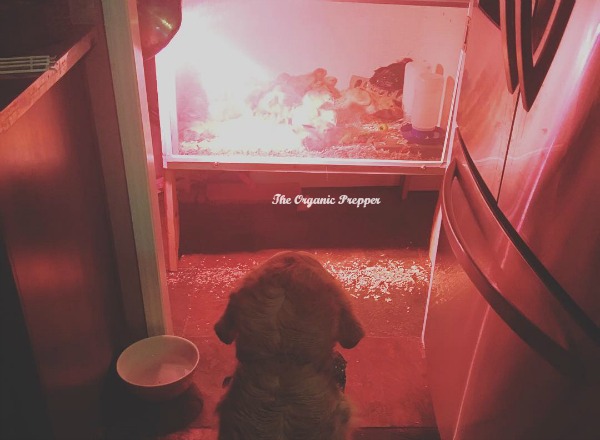
- If they’re all huddled together and making a lot of noise it means they’re cold and distressed.
- If they’re spread far apart, lethargic, and panting, they’re too hot.
- If they’re active, randomly spread out, and making happy little peeping noises, they’re just right.
My dog paid an unnerving amount of attention to the baby chicks in their brooder under the heat lamp. (see image)
What Can You Use For Bedding?
I used wood shavings for bedding, but you can also use straw. Be sure not to get something artificially scented, as this can cause respiratory problems for the delicate babies.
For the first couple of days, I put paper towels on top of the bedding so I could see their poop. See the section on health issues for the reason why.
You’ll Need Containers For Feeding and Watering Your Baby Chicks.
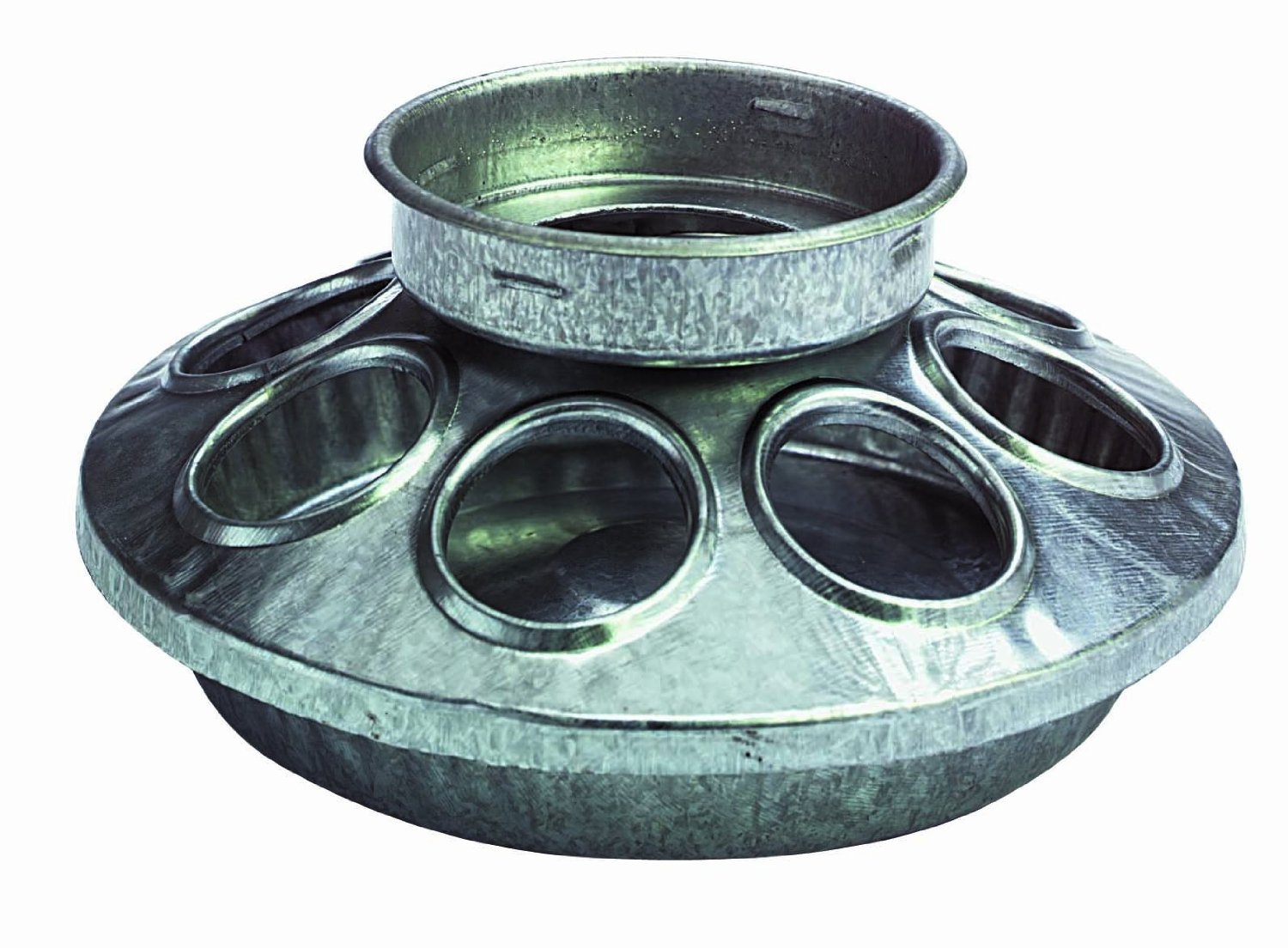
I have a couple of different feeders for the littles.
These are awesome because they are inexpensive and they simply screw on the bottom of a regular mouth quart jar. The jars can easily be sanitized in the dishwasher afterward. (They’re less than $8 at the time of publication.)
I also had the one in the second image. I had so many chicks in one batch that I had to set out 3 feeders for them to be certain everyone got something to eat.
It’s Important to Note That a Lot of Baby Chicks Die From Drowning.
It’s heartbreaking to see and thankfully it never happened to us! But baby chicks are like any baby. Any water they can potentially fall into poses a drowning hazard. There are two ways to avoid this.
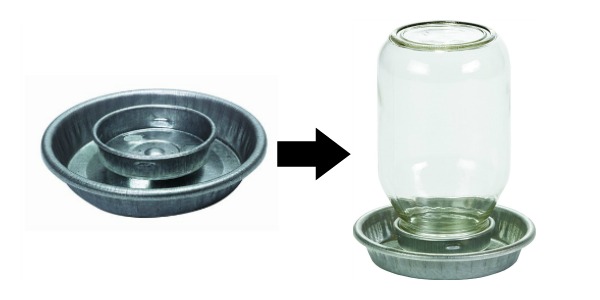
#2. You can use a bigger one-gallon water dispenser, but line the trough area with pebbles. This way, they can still get a drink but there isn’t room for them to fall in and be unable to get out. You will only have to do this for a week or so before they’re too big to fall in.
I raised the water dispenser up just a little bit to keep it from getting filled with bedding. The bedding can soak up the water like a sponge, leaving you with thirsty babies. You can use just about anything to raise it up. I put a couple of pieces of scrap wood beneath my waterers.
The benefit to this one is that you won’t need to replace it as they grow. I used this kind of waterer for my grown chickens, too.
What to Feed the Baby Chicks
There are several different types of food on the market for baby chicks. You can get some inexpensive starter, but you probably aren’t giving your chicks the best beginning with it. It’s like feeding them fortified cereal. Instead of food with actual nutrients, the nutrients are artificially added to a stripped product. They’ll probably survive, but they won’t be as healthy as chicks fed a better quality of food.
The next debate is whether or not to give them medicated feed. Some people swear by giving them medicated feed for the first few weeks of their lives. The claim is that all of the medication will be out of their systems by the time you consume the eggs (or the chickens if you’re raising them for meat.) It provides them with immunity to coccidiosis.
What to Feed Them If Your Goal is to Have Organic Eggs or Meat
Many people are raising chickens to provide them with organic eggs or meat at a better price. If that is your goal, you’ll want to go with an organic food. This starter is a high-quality organic product at a reasonable price.
Another option is GMO-free feed if you aren’t worried about strictly organic. It’s a good happy medium between the low-quality “Doritos” chicken feed and the expensive organic feed. You can usually find a good quality GMO-free crumble at your local feed store.
I always started out with crumble, which is coarsely ground, and as they got bigger, I mixed the crumble with the pellets. I liked pellets because there was far less waste. I also liked to supplement them with fresh fruits and vegetables. However, if you are supplementing them, be sure to provide a little dish of grit to help with their digestion.
Baby Chick Health Issues
Obviously, prevention is key. One great way to prevent illness in your chicks is to add 2 tbsp. of apple cider vinegar to a gallon of water. (Get the good kind with the mother – the cheap stuff does absolutely nothing.) You can also get those little packets of probiotics to add to their water, but mine have been just fine with the ACV.
Coccidiosis: Remember how I said I put paper towels over the bedding for the first few days? That’s so I can check their poop. It’s important to check that on a daily basis. You’re looking for anything bloody. (Turn off the red heat light if you’re using one because you can’t see bloody stool under a red light.) If you see anything with even a tinge of blood, you need to act immediately. This is a symptom of coccidiosis.
It’s not difficult to treat. Although this medication is labeled for use with calves, it can be used for baby chicks if you water it down sufficiently, as per the local feed store. Add 2 teaspoons of Corid to a gallon of water. They’ll generally consume enough if they aren’t too sick to drink.
- Here’s an article with more information about coccidiosis in poultry.
Pasty butt: I lost several chicks in my first flock to pasty butt and it absolutely broke my heart. This is evident when their vent gets sealed shut with poop. If it becomes clogged, the waste backs up in the chick’s system and they can’t pass their waste. It’s essential during the first week or two after bringing them home to check everyone’s bottom twice daily. If there is a little clump of poo on the bottom, you have to act.
You will have to very gently remove the clump on their bottoms. BE CAREFUL. Just pulling on it can actually disembowel the poor baby. Also, you need to be certain it’s the vent and not the umbilical stump.
This Video Shows You How to Clean the Chick’s Bottom.
- This article gives you more information about pasty butt.
- This article discusses a variety of chicken illnesses and symptoms.
How to Raise Your Chicks.
So…you’ve got your babies home. They’re safely ensconced in the brooder. What now?
You need to keep them fed, watered, and warm. That’s about it!
- I free-fed my chicks and tried to make sure there was always food available for the first month or two.
- There should always be fresh water in the coop or brooder.
- Keep the temperature at the right range for their ages.
- Handle them briefly and gently a couple of times per day so they get used to you. It’s much easier to raise them if they aren’t terrified of the giant human.
- Check their bottoms 2x a day for signs of pasty butt. (You can do this while you handle them.)
Excellent Resources to Help You Raise Your Baby Chicks.
- Chickens from Scratch
- How to raise baby chicks naturally
- Chickens: Naturally Raising a Sustainable Flock
- Raising Day Old Chicks
- How to Get Ready for New Baby Chicks
- 9 Things You Need for Starting Baby Chickens
- Introducing the Chickens
- Raising Baby Chicks
Raising Chicks for Meat? There Are a Few Differences.
If you’re raising chickens for meat instead of for eggs there are some minor differences. While the basics are the same, there are some breed differences of which you should be aware. These articles can help you.
When They’re Big Kids…
Once they graduate from the brooder, it is time to introduce them to the rest of the flock. This can entail some bloodshed, so you need to be careful and supervise them well.
I housed one batch of my chicks in a dog kennel inside the coop with the Bigs. We had an awful storm one night and the kennel began to flood. I had no option but to mix the flocks immediately, and fortunately, it went well. That was, in part, because they were already accustomed to one another through the safe barrier of the kennel.
- Here is an article about introducing baby chicks to your flock
Why Should You Raise Your Own Chicks?
First, let me get on my animal-lover soapbox for a minute. The poultry and egg industries are enough to make you sick – both physically and emotionally.
More and more information is coming to light about the horrible mistreatment of the birds that provide us with meat and eggs. It’s enough to make a carnivore turn vegan. And don’t even get me started on the food safety risks or raising animals the way that they do. If the creatures you consume for sustenance are ill then how can you expect to be healthy when you eat them? If they must be on antibiotics their entire tortured lives to survive, then is this really something you want to feed your family?
If you want more details, here is a horrifying, graphic article about the chicken industry. (No, it’s not by PETA – it’s by a friend who eats meat.) If you aren’t choosy about the chicken and eggs you purchase, you are, by default, endorsing this horrific abuse. *climbs off soapbox*
If you can’t or won’t raise your own chickens, please consider finding a local farmer who raises his or her animals the traditional way and buy from them. Your business means a lot to them, and voting with your dollars is the only way to make Big Agri change their horrific practices.
On to More Positive Reasons.
When you raise your own chickens, you learn first-hand where your food comes from. You know what your birds ate and that they are healthy. And you will also know that they haven’t been given risky supplements or medications, and that they were treated humanely. Unfortunately, the labels at the grocery store are basically meaningless, with the exception of “pasture-raised.” That’s a lot closer to what folks envision when they think about ethically raised poultry.
It’s also very economical to raise your own chickens. Have you checked out the price for organic, pasture-farmed eggs recently? Ouch! My hens ate about $20 worth of food per month and spent their days controlling the bugs and weeds for me. In return, I ended up with 3-4 dozen eggs per week. Now, we couldn’t eat all of those eggs, but they made lovely gifts for friends without farms, and our Great Pyrenees loved them as an addition to his dinner.
I got a lot of joy seeing my goofy hens frolic around the backyard. Each one had a distinct personality, and because they were hand-raised, they were all pretty friendly. If I walked out into the yard, I found myself surrounded by happy, feathered friends. My laying hens were like pets that provided us with eggs.
Questions or comments?
If you are a veteran chick raiser, please provide your best tips below! If you are new to chickens, let me know what’s holding you back from starting your own flock. Do you have any questions that I might be able to help with? I hope this article encourages you to take the plunge!
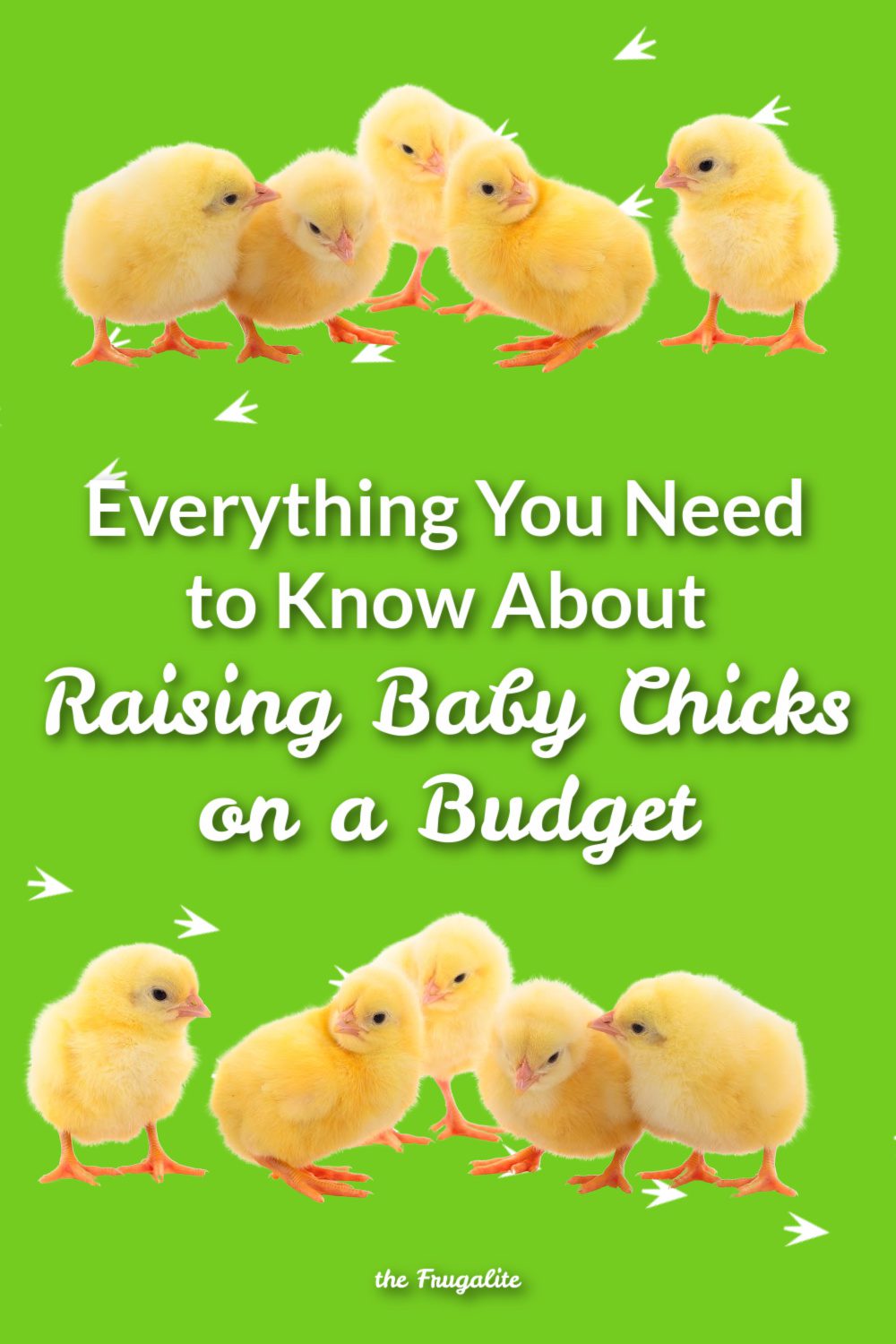


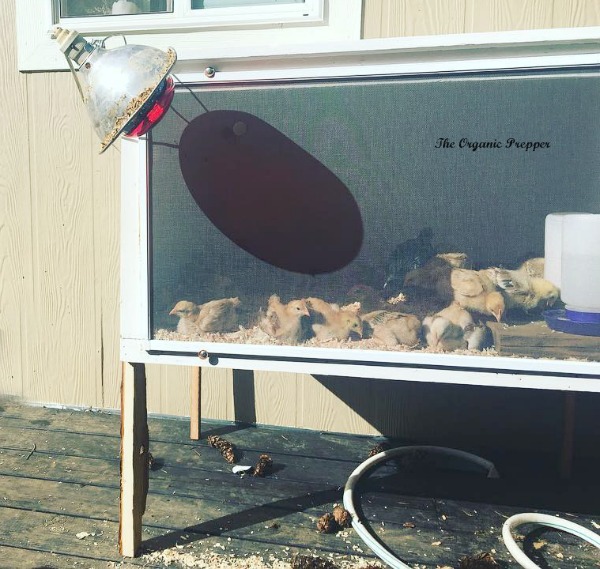
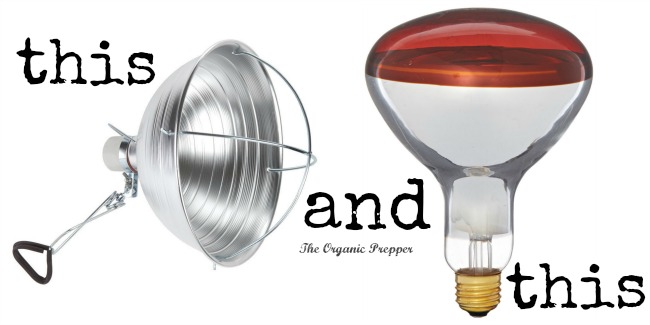
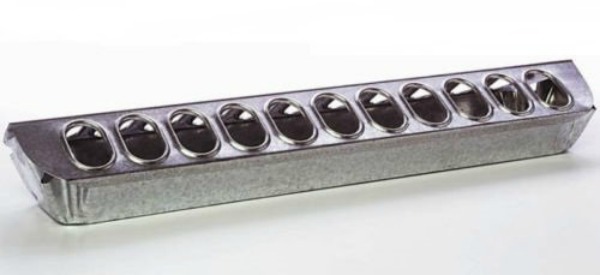
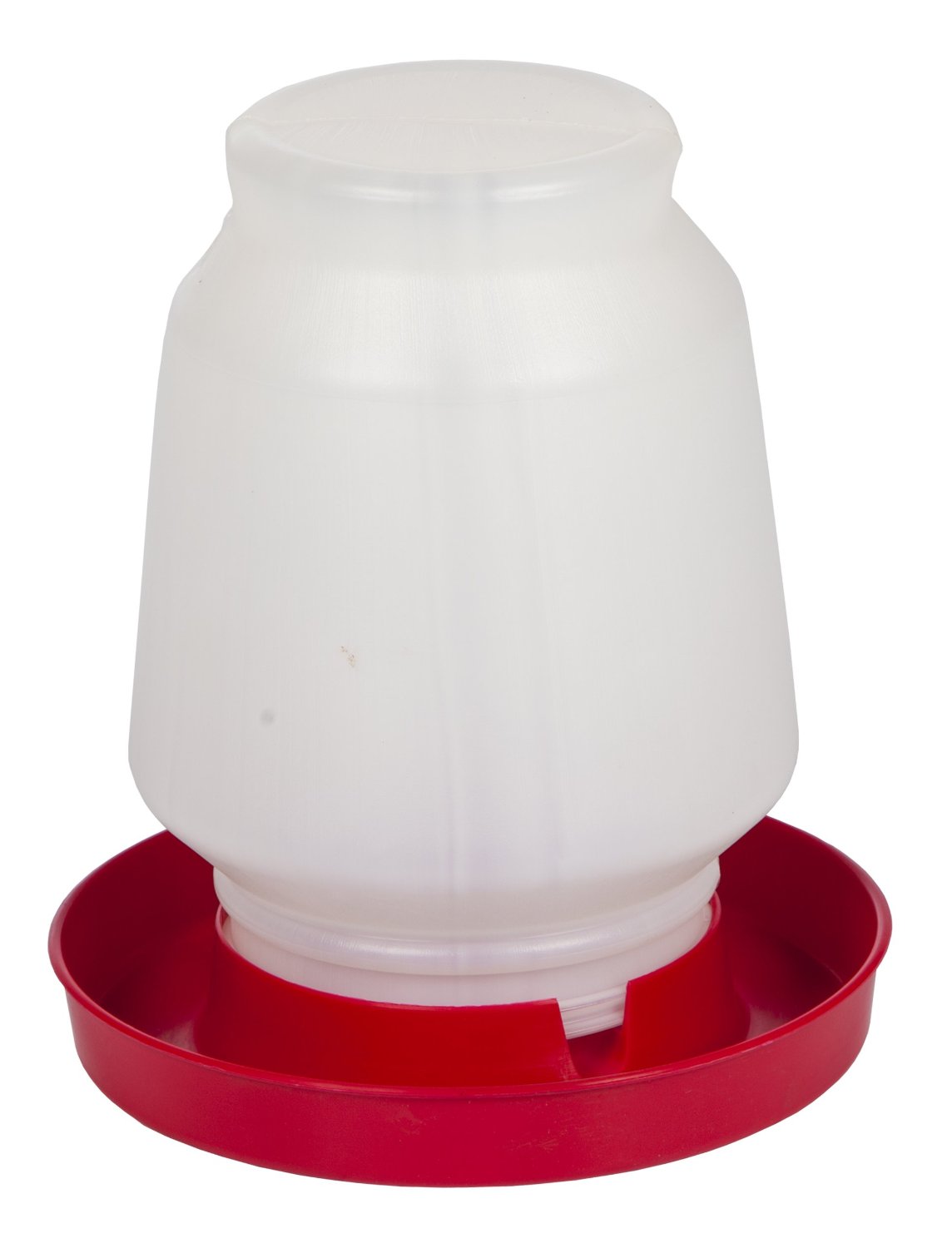









8 thoughts on “Everything You Need to Know About Raising Baby Chicks on a Budget”
We have raised chickens for over 30 years, every 2 years we order a new batch of day old chicks from Murray McMurrary Hatchery. Love this company and rarely ever loose a chick. It’s pretty straight forward as Daisy said, quality food, water, warmth and keep the stinky butt away. It was years before I actually new it had a name for a clogged up butt. It happens to most baby animals also.
I absolutely love picking out chicks in advance of delivery. Always picking my favorites and sometimes adding interesting new ones. A nice colorful, with year round laying hens and a gentle rooster is perfect flock for me.
If you are looking for the most docile rooster for your flock, look for Bielefelder.
He is very attentive to his girls but isn’t aggressive to people.
Australorps, Orpingtons and some Rocks lay year round. While others skip laying in very hot or very cold weather.
Murray McMurray Hatchery website gives so much information about each breed whether you’re looking for free ranging, mostly to all confinement, just for meat or for duel purpose breeds. They even provide personality and quality breed profile to help you choose for your specific needs, (and no I don’t work for them, I’m just a happy customer).
We pick them up between 4 am and 6 am at our local post office. I don’t think the post office personnel really like live animals in their way so we get them as soon as they arrive. I believe this key to a safe and alive batch of two day old baby chicks
If you go by the post office a day or two before the chicks are shipped and speak with them, they will happy to call you immediately when they arrive.
D
Excellent article, But just to clear up some common confusion, you don’t need a rooster to get eggs. (For the prepper, a rooster is just an extra mouth to feed.) An egg is NOT a chick; an egg is an EGG. As a simple (if somewhat crude) analogy, a woman lays an egg once a month. A female chicken lays an egg once a day. In neither case is the egg a baby. It’s only an egg until it’s been fertilized by male sperm. Only then can the egg develop into a baby. With chickens, the mother is called a hen; the father is called a rooster. Everybody of my grandfather’s generation, city-dwellers included, understood these things. You might be amazed at the number of college-educated folks, today, who do not understand these things.
True you don’t need a rooster. And they do make noise which may be undesirable in certain locations. But chickens do not lay forever. In a survival situation they may be an extra mouth to feed but once something happens to that hen it’s unlikely you’ll be able to replace it. If the situation is only a few months or even a couple years okay. But if its long-term you’ll find it worthwhile to have that fertilized egg since a chick could be used for barter. As well as maintaining your stock.
I should have mentioned that I wrote an article myself, rather a long time ago, on homemade chick brooders. It was in the March 1982 issue of Backyard Poultry magazine. The article (illustrated) was entitled “Build a Better Brooder.” Backyard Poultry is still in business. You can Google for it. Today it appears to be an electronic magazine as well as paper but I doubt you can retrieve a 39-year-old article.
My brooder design was a wooden box, 4 feet long and 2 feet wide. It was split in half with a cloth curtain — strips of cloth hung vertically — that allowed the chicks to travel from one end to the other. One end had a light bulb for heat. The other end was a place for the chicks to escape from the heat. They simply traveled to where they felt most comfortable. It worked very well. I still have it and still use it.
I started out with free chicks from a guy with very broody hens. I still have two hens from that original bloodline so I always have a broody hen or two each spring raising 6-8 new chicks. I keep a roo or two around. So each year I have new hens being added to the flock. And excess roos become fried chicken around 6 to 8 weeks old. If I end up up with more hens than I want some become boiled chicken for chicken and noodles or I may sell off a few young hens. I’ve even given a few as a starter flock to friends or family. A lot of commercially raised chicks don’t get so broody. I still like to watch a hen raise her babies. She teaches them to eat or drink. If free range they learn to forage from her. She keeps them the right temperature from egg laying to nearly grown. She covers them in a storm and protects then when they are little. I have a hen with 7 half grown chicks. I still love watching them but like all teenagers they are getting rather independant.
I like to keep a roo in the pen with most of the chickens and a roo or two with just two or three free range hens. The roos not only keep the species going but are protective of the hens under their care. For free range chickens that’s particularly important.
If I were buying or hatching out 25 to 50 at a time I’d do it your way. I do have the ability to hatch up to 50 eggs at a time and I keep clip on reflector lights but I’ve never bothered. The hens do a great job and make it easy for me. If I were buying chicks to start over I’d look for some that are more likely to get broody and let them raise chicks rather than replace them all every couple of years.
For keeping the two of us in eggs I don’t need a big flock.
You are accurate and quite complete.
Over the decades I literally raised hundreds of chickens. Although I once did, I no longer find them worth the time or trouble to raise for meat. One day that may change. And I only keep a 2-3 dozen of different varieties nowadays instead of what I used to keep. I have the classic leghorns which are the best production layers of white eggs. Rhode Island Reds Barred Rock for the brown eggs and the Easter egg chicken “Araucanas” for the
bluish green eggs. The last breed is somewhat quiet when they cackle actor laying. I do have guineas but they just wander around the yard and Roost in the trees. I keep them for tick reduction. Every couple years I get quail and pleasant to release Wild. And the turkey’s I had a few years back crossbred with the wild turkeys. Opp’s!!! Our area now has turkeys that are much larger, and whiter LOL purely by mistake. I no longer keep turkeys as it’s not uncommon to see eighty to a hundred of them running around.
When raising chicks sometimes misting them with a water bottle once or twice a day helps their feather production. And once a day I use a single paper towel per chick wiping them all down including their bottoms. This really helps imprint them on you. As well as helping keep them clean.
???
???️?
I should have also said in regards to feed. If you get a large wheeled plastic trash can. Wally world comes to mind. The vertical cans will hold 3 50 lb bags. And the larger horizontal cans can hold as much as 6 50-lb bags. This helps keeps Critters such as mice out. Squirrels and raccoons have a tendency to want to chew on them if you leave them outside. But they do make good storage bins for all kinds of feed including dog food. This is what I used in the feed room in the barn. If your chickens are free roaming. You likely won’t use more than a 50 lb bag of scratch in a month in a 50 lb bag of egg Mash every other month or a dozen or two chickens. Right now all I’m putting out is Mash. Since there are literally thousands of grasshoppers for them to eat. So anyway storing a few months of feed in these cans is quite easy.
??
So what did people do 1 or 2 hundred years ago without all the fancy bagged food? How did the birds survive without all the specialty food?
I never understood why you had to spend so much on so many different types of food for chickens.
Didn’t they all just free range and maybe people gave them some cracked corn they grew?
It just seems like people have now made it so much more complicated and expensive